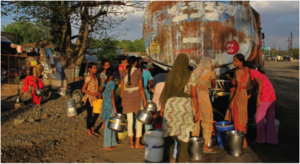A tanker truck lumbers into a neighborhood, and people rush to the truck carrying containers of all sizes and colors. A man on a motorbike with a bubble top container in tow winds down narrow alleys in an urban slum. A woman brings over buckets to fill water from a neighbor who has piped water provided by the city. Children carry water containers home from the neighboring community.

Cities in the developing world have not been able to keep up with supplying the water needs of growing populations. In most of these cities, an urban water market has emerged. The water market in the cities of the developing world is incredibly diverse. It ranges from people with water reselling to their neighbors, to entrepreneurial middlemen selling treated water directly to people’s homes, and tanker conglomerates that supply water to neighborhoods. Prices range greatly in the urban water market, and can shift from month to month, as water sources dry up and new ones are tapped through the year. These water markets are rarely if ever regulated by government authorities to ensure affordable prices or water quality.
It took us nearly a year to document the variety of prices and sources available in the urban water market of a medium sized city. What we found was tremendous variation in the types of vendors and the prices paid from month to month and from the different types of vendors. From the wet to the dry season, prices from private suppliers could double. Similar to the piped water system, poor people were not well served by the informal water system. And that fact is why Atma is focusing on the peri-urban water market. Our goal is to improve information flow and by doing so, reduce price disparities and improve the quality of the service.
